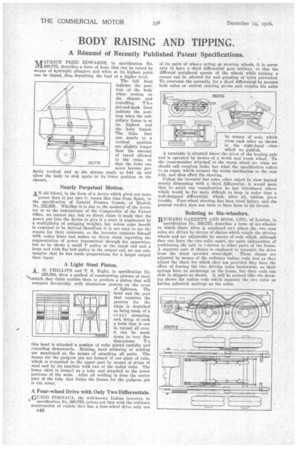BODY RAISING AND TIPPING.
Page 70

If you've noticed an error in this article please click here to report it so we can fix it.
A Résumé of Recently Published Patent Specifications.
1/rAURICE FRED EDWARDS, in specification No. 1V1260,775, describes a form of body that can be raised by means of hydraulic plungers and when at its highest point
can be tipped, thus depositing the load at ft higher level.
The full lines indicate the position of the body when resting on the chassis and travelling. The dot-and-dash lines indicate the position when the subsidiary frame is at its highest and the body tipped. The links that rise nearly to a vertical position are slightly longer than the amount of travel allowed in the rams, so that the links can never become per
fectly vertical and so ate always ready to fold up and
allow the body to sink again to its lower position on the chassis.
Nearly Perpetual Motion.
AN old friend, in the form of a device which gives out more power than is put into it, comes this time from Spain, in the specification of Gabriel Peramo Gomez, of Madrid, No. 232,629. Whether it is due to the modesty of the inventor or to the instructions of the Comptroller of the Patent Office, we cannot say, but no direct claim is made that the power put into the device to give it a start is augmented by a multiplicity of swinging weights, but unless some benefit is expected to be derived therefrom it is not easy to see the reason for their existence, so the inventor contents himself with veiled hints and makes no direct claim regarding the augmentation of power transmitted through his apparatus, but as he shows a small V pulley at the input end and a large and wide fiat belt pulley at the output end, we can only imagine that he has made preparations for a larger output than input.
A Light Steel Piston. A H. PHILLIPS and T. S. Rigby, in specification No.
259,050, show a method of constructing pistons of steel, Nushich they claim enables them to produce a piston that will compare favourably with aluminium pistons on the score of lightness. The head and the part that contains the grooves for the rings is described as being made of a steel stamping, and, being of such a form that it can be turned all over, it can be made down to very fine dimensions. T o
this head is attached a number of webs placed radially and extending downwards. Brazing, hard soldering or welding are mentioned as the means of attaching all parts. The bosses for the gudgzon pin are formed of one piece of tube, which is ccnnected to the upper part by mean st of strips of steel and by its junction with two of the radial webs. The lower skirt is forroBi as a tube and attached to the lower portions of the webs. After all welding is done the centre Part of the tube that forms the bosses for the gudgeon pin it cut away.
A Four-wheel Drive with Only Two Differentials.
CIUIDO FORNACA, the well-known Italian inventor, in
• "specification No. 2t10,785, points out that with the ordinary construction of vehicle thet has a four-wheel drive only one
of its pairs of wheels acting as steering wheels, it is necessary to have a third differential gear midway, so that the different peripheral speeds of the wheels while turning a corner can be allowed for and grinding of tyres prevented. To overcome the necessity for a th;rd differential he mounts both axles on central steering pivots and couples his axles by means of rods which cross each other as shown in the right-hand view which we publish.
A turntable is situated above the pivot of the leading axle and is operated by means of a worm and worm wheel. To the cross-member attached to the worm wheel are what we should call coupling links, but what the specification refers to as ropes, which connect the worm mechanism to the rear axle, and thus effect the steering.
Unless the inventor has some other object in view beyond merely dispensing with a third differential, it would seem that to avoid one complication he has introduced others which would be far more difficult to keep in order than a well-designed differential, which, after all, seldom gives trouble. Four-wheel steering has been tried before, -and the general verdict does not seem to have been in its favour.
Relating to Six-wheelers.
RICHARD GARRETT AND SONS, LTD., of Leiston, in
specification No. 260,755, describes a form of six-wheeler in which chain drive is employed awl where the two rear axles are driven by means of chains which couple the driving wheels and ale adjustable by means of rods which, although they can force the two axles apart, are quite independent of positioning the axle in rslation to other parts of the frame. A separate pair of chains is employed to transmit the drive from the usual sprocket cross-shaft. These chains are adjusted by means of the ordinary radius rods, and as they adjust the chain for which they are provided they have the effect of forcing the two driving axles backwards, as their springs have no anchorage on the frame, but their ends can slide in slippers as shown. It will be noticed tisk the drawing shows the radius rods which separate the two axles as having spherical seatings on the axles.












































































































